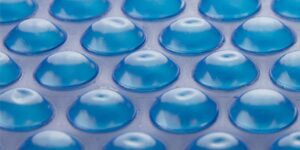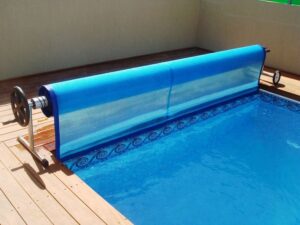Solar Pool Cover Bubbles Up or Down? A solar pool cover, also known as a solar blanket, is designed to use the sun’s energy to heat the pool water, retain that heat, and reduce evaporation. One common question among pool owners is whether the bubbles on a solar pool cover should face up or down. The correct orientation is bubbles down, with the smooth side facing up. Here’s a detailed explanation of why this is the correct setup and how it works, covering all aspects you need to know.

Understanding Solar Pool Covers
Solar pool covers are made from a durable, UV-resistant plastic material that contains air-filled bubbles. These bubbles resemble bubble wrap and are integral to the cover’s functionality. The primary purpose of a solar cover is to harness solar energy to increase the water temperature, retain the heat overnight, and minimize water and chemical evaporation.
The Correct Orientation: Bubbles Down
Heat Absorption and Transfer
- Maximizing Solar Heat Absorption: When the cover is placed with the bubbles facing down, they come into direct contact with the water. The transparent or translucent material allows sunlight to pass through and the bubbles trap the heat from the sun, transferring it directly into the pool water. The air within the bubbles acts as an insulator, reducing the loss of heat back into the air.
- Efficient Heat Retention: The air pockets in the bubbles provide an insulating layer. This is similar to how double-glazed windows work. By having the bubbles down, the heat trapped during the day is more effectively retained in the water overnight, which helps maintain a higher water temperature even when the air temperature drops.
- Enhanced Heat Transfer Efficiency: Water is an excellent conductor of heat. By having the bubbles in direct contact with the water, the heat transfer is more efficient compared to having the smooth side in contact with the water.
Reducing Evaporation
- Minimized Water Loss: The bubbles create a barrier that significantly reduces water evaporation. When the bubbles face down, they form small pockets of air that disrupt the surface tension of the water, reducing the rate at which water molecules escape into the atmosphere.
- Chemical Retention: Along with reducing water evaporation, placing the bubbles down helps in retaining pool chemicals. This is because less water evaporation means less chemical loss, which saves on maintenance costs and effort.
Durability and Practicality
- Wear and Tear: The smooth side of the cover is more resistant to wear and tear compared to the bubbled side. When the smooth side faces up, it is less likely to get damaged by external elements such as debris, UV rays, and physical impacts.
- Ease of Use: Placing the bubbles down makes it easier to remove the cover from the pool. The smooth side facing up glides more easily over the water surface, making the process of putting on and taking off the cover less cumbersome.

Installation and Maintenance Tips
- Initial Installation:
- Unpack and Spread Out: When you first receive your solar pool cover, unfold it and lay it out flat on the ground, bubbles facing down, to remove any wrinkles.
- Cut to Fit: Use a pair of scissors to trim the cover to fit the exact shape of your pool, ensuring that the bubbles are always facing down during this process.
- Regular Maintenance:
- Cleaning: Keep the cover clean by periodically hosing it down to remove dirt and debris. Clean the cover while it’s on the pool with a pool brush to avoid dragging it around and risking damage.
- Storage: During the off-season or when not in use, store the cover in a shaded area to prevent UV damage. Use a reel for easy handling and to avoid folding, which can lead to cracks and tears.
- Longevity:
- Avoid Chemicals: Do not expose the cover to excessive chlorine or other pool chemicals. High chemical levels can deteriorate the material.
- Repairing: Small tears or holes can be repaired with a solar cover repair kit, which typically includes adhesive patches.
Conclusion
The correct orientation for a solar pool cover is with the bubbles facing down and the smooth side facing up. This setup ensures optimal heat absorption and retention, minimizes evaporation, and enhances the durability of the cover. By following proper installation and maintenance practices, you can extend the life of your solar pool cover and maximize its benefits, making your pool warmer, reducing water and chemical loss, and ultimately saving on energy costs.
Read Also.What is a Piggyback Breaker and Advantages & Types